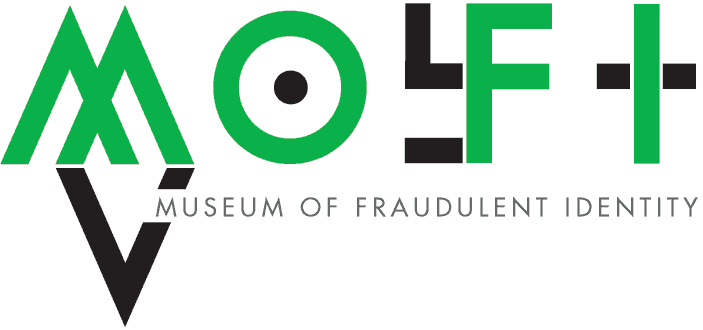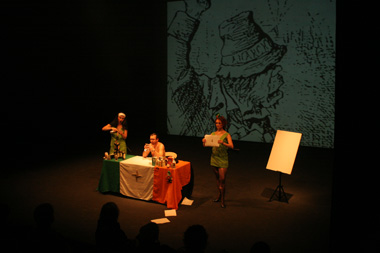 |
| Dylan Tighe: logo for Museum of Fraudulent Identity; courtesy the writer |
The bar of the Project Arts Centre in Dublin is swathed in flags: flags for Sinn Féin, for Irish nationalism, for the Unionist movement, and for the Republic of Ireland. One side of the room is lined with exhibition tables, and the bar tables are dotted with beermats saying “MOFI: The Museum of Fraudulent Identity.”
This is the anteroom to Dylan Tighe’s performance Mise Éire, which takes place in the theatre next door. The exhibition tables are covered in memorobilia from Ireland’s recent history and from Tighe’s own life. Badges and recordings of the Pope’s visit in 1979, Tighe’s (bad) school reports, the Irish school history textbook, press cuttings of Tighe’s recent subversive performances. Two video monitors blast out the cloying stereotypes of American-Irish films. In the bar, two women in high heels, ripped tights, short green dresses and balaclavas are brandishing guns.
The display continues inside the theatre. A table is draped in the Irish flag and covered in kitsch and religious symbols of ‘Irishness’: a plastic leprachuan, a copy of the bible, a candle of Jesus’ face. The woman-guards are stationed either side. Tighe enters, naked and shackled – the embodiment of the ‘Irishness’ he has created.
‘Mise Éire’ translates from the Gaelic as ‘I am Ireland’, and is also the name of the republican Patrick Pearse’s well known poem from 1912. Starting from this evocative title down, the performance examines the component parts of Irishness – the elements that reproduce the whole – to deconstruct Irish identity itself.
The women have taken off their balaclavas. One lifts up a board with the number 1 written on it. The other opens a can of Guinness from the pyramid of cans on the table, and pours a measure into a chalice. She blows a whistle. Video footage starts up on the screen behind the stage. It is a woman, an Englishwoman, describing the Irish racism she encountered as a child. After a minute, we are shown the number 2, and another measure of Guinness is poured into the chalice. This routine carries on – Tighe drinking a shot of Guinness a minute – for over an hour.
Tighe’s Mise Éire sticks two fingers up at Irishness. Surrounded by the ephemera of Irish ‘identity’ – its national, religious and political history – Tighe drinks till he is sick, vomits on the Irish flag and stands, wobbly and giggling, for the national anthem. The whole performance is absorbed into the mindless, repetetive (meaningless?) ritual of drinking Guinness. A drinking game? A form of torture? I’m not sure why this prisoner is forced to drink at all – perhaps it’s to escape from the relentless affirmations of Irishness around him. Perhaps it’s to celebrate.
 |
| Dylan Tighe: Mise Éire, 2006, performance shot; photo Paddy O’Brien; courtesy the writer |
But whose Irishness is he escaping or celebrating? Willie White, the Artistic Director of the Project Arts Centre, was quick to ask this question in the after-show discussion. The video footage playing behind the stage largely narrates Irish republican history from the early 1900s to about 1992 (the footage was stopped when Tighe was sick). Isn’t that all history now? Modern Irishness is tied to progress, economic boom and Europe, not the UK. Its symbols might be technology and multiculturalism, not leprechauns and tacky religious ‘souvenirs’.
That’s because the Irishness Tighe’s Museum and performance present is seen from inside and from outside. A school textbook is part of Irish culture, but the tourist tit-tat is made for someone else. And, sitting naked as the embodiment of the symbols around him, Tighe performs a neat enactment of the political (outside) in the personal (inside).
The performance at Project Arts Centre on Halloween was Mise Éire ’s first presentation in Ireland; its earlier incarnations were in London in May and August of this year. Two shows – including this one – were followed by an after-show discussion, which revealed two very different reactions to the ‘Irishness’ Tighe portrayed. Rather than a generalised Irishness, it is Ireland from a particular angle – specifically, the angle from England. So how did English and Irish audiences react? What did their reactions say about the piece, and about Irish identity itself?
Set apart from us on the stage, lined up in a formal tableau, the three performers are put in a certain relationship with the audience. The setup is reminiscent of anthropological photographs from the nineteenth century: apparently simple, straight-on pictures that were meant to isolate the specimen’s racial essentialism. It was their simplicity that hid this racial intent, the racial intent that seeped from the methods of the anthropologist ‘civilizer’ to the eyes of the viewer. In Mise Éire, the audience is asked to take on this role – what Edward Said called “positional superiority” – in relation to the specimen on stage. (We’re also primed for it in our introduction via the ‘Museum’.) And it’s the relation that England, as colonizer, historically played against Ireland, the colonized. The ‘outside’ of Ireland seen here is the English perspective.
It’s not just the captive specimen that fulfils this kind of colonial imagination. The two female guards are a strange mix of sexual and physical violence. Their ripped tights, high heels and skimpy dresses imply a raw sexual power – even violent sexual conquest – but their guns and balaclavas speak of a tangible terrorist threat. They seem to personify a real and fantasy version of an ‘other’ to England: the sexual fantasy of a wild and reckless race, the terrorist reality of the IRA.
Is this the Irishness that Mise Éire lampoons? The stultifying view of a colonizing power? If so, it didn’t seem to bother a London audience. In East London, the audience reaction was one of polite, and self-conscious, concentration. Irish history is not taught in English schools (at least, not from an Irish point of view), so much of the historical narrative played on the video screens was new information. And, sufficiently distanced from a British colonial past, the English viewers took it in quietly and seriously.
In Ireland, Willie White and members of the audience wondered if Ireland’s identity really relies on England any more; English viewers accepted that it does. Partly, this is because people are used to seeing things from their point of view – if you’re English (or Irish, or American), then you see the world with England (or Ireland, or America) at its centre. But there’s also a more patronising undercurrent to the English reaction.
In the 1990s, to coincide with the quincentenary of Christopher Columbus ‘discovering’ America, the performance artists Coco Fusco and Guillermo Gómez-Peña locked themselves in a cage for three days, pretending to be members of an undiscovered South-American tribe ‘brought back’ to be put on display. During their performances in Europe and the US, they were surprised by how easily visitors slipped into a colonial stance – only addressing the ‘zoo keeper’, for instance, and not the artists (even if they objected to the politics of the display). The fact that anyone believed in the installation at all is frankly astonishing. Was the same thing happening to the English audience with the display in Mise Éire ? Perhaps the viewers’ meekness in watching a mythical Enlgish-Ireland betrayed the remnants of a naturalised colonial position – ‘positional superiority’. English people are so used to seeing Ireland not just in terms of themselves but as less than themselves, that the spectre of an Irishman exploring the results of that relationship seems natural. It is tolerated with liberal courtesy.
This means that Mise Éire is actually not about Ireland at all. It is about England: ‘I am Ireland as England sees me.’ Which brings me back to my first question – who cares? If England isn’t relevant to Ireland any more, then Ireland certainly isn’t relevant to England’s sense of self. The ‘Other’ that Ireland occupied for so many years in the English public imagination has been conveniently, and almost wholly, transposed to the spectre of Islamic movements and the conflicts in the Middle East. For the UK, the IRA has been demilitarised and Sinn Féin are (almost) respectable. England doesn’t need to define itself in relation to Ireland, either.
So why the colonial acceptance? There must still be remnants of a colonial psyche in the way that English people think about Irish people, and these deserve to be debunked. It’s also worth remembering that the performance was conceived in London, for a London audience. In Dublin, Tighe recalled the equal-opportunities monitoring forms he was made to fill out in the UK. His choice was either ‘ethnic Irish’ or ‘white European’. England clearly doesn’t share Ireland’s vision of a European future.
 |
| Dylan Tighe: Mise Éire, 2006, performance shot; photo Paddy O’Brien; courtesy the writer |
But it would be unfair to say the performance was only about England. It’s about the way identities are created and performed – the mannered and oppresive repetition of symbols, of stories, of ritual. There is an ‘inside’ element to counter the ‘outside’ view that seems to speak from Ireland, even if it doesn’t reach any conclusions. The video in particular is all taken from Irish TV and, although much of it was familiar to an Irish audience, it has a shaky, disjointed aesthetic like a messy train of thought. It starts when Tighe starts drinking and stops when he stops, like a projection of his own confused mind. Altogether, the cultural detritus, the historical narrative, the fetishism and the dogmatic ritual of Mise Éire throw up a confusion of Irishness, an inability for it to escape the past and forge a new identity, whether that identity is one made by Ireland, or one (partly) shaped by someone else.
One of the first questions both audiences asked was, “What happens next?” – where was the video footage going? By cutting off abitrarily, the video refuses the ‘closure’ of any definition of Ireland. The (anti)climax of the piece is Tighe’s physical rejection of what is happening. It speaks of a crisis of Irishness itself, and from any angle.
But it’s the difference between the audience’s reactions that proves how relevant Mise Éire is to modern Ireland. Firstly, it highlights the sticking power of old opinions. For English audiences, it reveals the temptation to fall into privileged patterns of behaviour – however archaic and politically incorrect. And for Irish audiences, it contains a parable about future behaviour. One audience member in Dublin congratulated Tighe on his use of republican history. Ireland must remember its past, he said, in order to define itself against the influx of people arriving with immigration. But this view is just another form of positional superiority. Now Ireland is in a position of cultural and economic strength, it must be careful not to adopt the bad habits of others. Constructing an Irish identity from its troubled past that subjugates newer, weaker parts of society is a double betrayal – a betrayal of history and of the future. Mise Éire highlights the danger of new opinions.
Mise Éire was conceived for a London audience and so was necessarily London-centric in its approach. But the issues it raised are just as relevant to an Irish audience, who – in the case of the show at the Project Arts Centre at least – are well equipped to deconstruct the component parts of identity it contains. Rather than dwell on a dusty colonial past, the performance (as its Museum’s title suggests) highlights the fraudulence of any definitions of identity. In fact, it points out the flaw in the impulse to classify at all. Like the boxes on the equal opportunities form, the elaborate rituals and display that make up Mise Éire point out the absurdity of classification.
Mary Paterson is a writer and curator based in London.